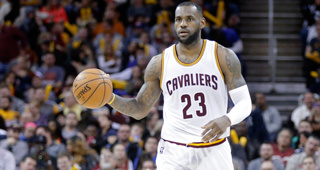With a seemingly endless break before the start of The NBA Finals, nearly every angle of the matchup between Golden State and Cleveland has been examined on all corners of the internet. And while things like Kyrie Irving’s defense or how the Warriors shape their transition attack to cope with the offensive rebounding machine that is Tristan Thompson will certainly impact the outcome of the series, everything will ultimately come down to one man: LeBron James.
Injuries to Kevin Love and Kyrie Irving during these playoffs have made the Cavs heavily reliant on James for their offensive (and overall) success. And how the team is utilizing the best player on the planet isn’t all that varied. Partly because his broken jumpshot have made opponents even more bold in ducking under pick-and-rolls, James has spent an incredible amount of his time operating in isolations.
James leads all players in the playoffs in isolation situations with 10.6 charted plays per game, according to Synergy data (the next closest is James Harden at ‘just’ 7.3. Slowing James -- because let’s face it, stopping him is not a real option -- in this situations is priority number one for Golden State this series. And as some have written about already, the Warriors have a stable of players capable of spending defensive possessions and James and making him work hard for his points.
But who guards James in isolations is only half the equation. These one-on-one affairs can often be viewed like a showdown in the Old West, but there are subtle concepts teams employ that shape an isolation possession’s ultimate success or failure. So while whoever guards James on Golden State will likely bring their own unique style and set of attributes to the table, they will still be operating under the coaching staff’s desired philosophy -- an edict that will go a long way in shaping how this Finals plays out.
The previous two opponents James faced -- Chicago and Atlanta -- took opposite approaches to defending him in iso’s. The Bulls, as they’ve done for years under recently departed head coach Tom Thibodeau, used a ‘funneling’ technique designed to shepard James into eagerly awaiting or ‘pre-rotated’ help defender.
Everything about the way Chicago defended James can be traced back to one starting point: the on-ball defenders stance. In the above clip, the Bulls’ Jimmy Butler aligns himself on James high (right) hip, staggering his feet in an effort to close off the middle of the floor and force Cleveland’s superstar forward into Joakim Noah’s path. This type of “closed” stance is essentially an invitation to to make a player operating in an isolation play one on two while the rest of the help defenders shrink the floor behind the play.
The overarching philosophy behind such a tactic is that sending a dangerous player to a spot on the floor where you know help is coming -- even if it means creating a string of rotations -- is better than a situation where someone like James can try to go wherever he wants. It essentially forces the offensive player to take a tough shot at a numbers disadvantage or try to read the rotating help and find an open teammate for a shot. Those options sound pretty solid in theory, but one of the downsides is demonstrated in the previous clip as Cleveland’s Tristan Thompson sneaks around all the shuffling Chicago defenders and grabs an offensive rebound.
Perhaps because of a desire to avoid situations like this, the Hawks went with the exact opposite approach, based once again with how the on-ball defender aligned himself with James. Instead of using a ‘closed’ stance in an attempt to push James to a particular spot on the floor, Atlanta’s defenders were under instructions to square him up -- keep their chest and feet mirrored with James’ -- and sag back sightly to encourage a jumper.
As you see in the clip, James, instead of being pushed baseline, gets to the middle of the floor. And while most coaches agree this is bad, the good is what is happening behind the play. Because Atlanta’s Paul Millsap does a superb job of staying in front of James, no other Hawks are forced into help rotations thus able to stick tight to shooters and the lurking Thompson. This result underscores the desired effect of this strategy -- let James get his going one-on-one, but don’t create situations that allow for his teammates to find offense.
The downside to this strategy, however, is probably pretty evident.
In news to no one, James can and will get his against teams that minimize help during isolations. Whereas a team like the Bulls would have tried to send James to the more crowded side of the floor in that situation -- opening up drive-and-kick opportunities in the process -- the Hawks were willing to live with James operating as volume scorer. Such an approach has merit, but James can singlehandedly win a series with some brilliant offensive displays, especially if his jumper gets back on track.
Golden State has a quintet of perimeter defenders capable of battling James, so they can certainly try to employ the same strategy as Atlanta. Yet at the same time, Andrew Bogut’s presence on the backline and the Warriors overall team speed and ‘switchability’ makes forcing James to their defensive stalwart and rotating behind the play justifiable as well. In just a little over 36 hours, we will see how Steve Kerr and the Warriors choose to handle James. And that decision may decide the destination of the the Larry O’Brien trophy.



